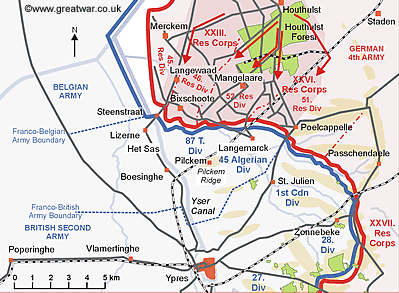 German troops
move to the battle zone to launch the attack
German troops
move to the battle zone to launch the attack
21 April 1915
In the night of 21st April the German troops received orders for a third time to “Stand To”. This was the third attempt by the German 4th Army to launch the attack with gas.

Leutnant Richard Drach was the commander of the 4. Company of 238. Reserve-Infanterie-Regiment on at this time. His personal account of experiences during the Second Battle of Ypres writes of the move into the battle zone on the night of 21st April. The regiment had moved into barrack huts in Houthulst Forest in the early morning of 20th April:
“On 21 April we were in the barrack huts in the wood. At 10pm [British time] we were “Stood To”. For the third time we marched to Mangelaare and on to take up our assembly positions. The 4. Company dug cover trenches about 250 metres behind the fire trench where the 2. Company (commanded by Leutnant Gratwohl) had taken up their position. It was a cold night!” (1)
An account by Leutnant Becker of III. Battalion 238. Reserve-Infanterie-Regiment describes the situation in the front line trench on the night of 21st April:
“We spent the night in the front line trench brimming with confidence. The pioneers came and checked the locking valves on the steel cylinders. The gas was trapped inside the cylinders under high pressure. Harmlessly the cylinders sat there in the Flanders mud. The pipes through which it would be released nestled in amongst the breastworks, hidden from view. Our only protection against the gas consisted of a moist cotton pad with straps to press it against our mouth and nose.” (2)
The account by Oberleutnant Mattenklott of the II. Battalion in the same regiment described the preparations for moving into the battle zones and the preparation of the gas canisters for an early morning attack:
“21.4.15: A regimental order was issued that the men were not to carry out duties during the afternoon but were to rest. We concluded that something was up. At 8pm [British time] we received orders that the 5. and 8. Companies were to be in the trenches at 11.20pm [British time]. The 6. and 7. Companies were to be in support in the communication trench on our left. We marched off punctually and on 22 April just after 11pm [British time] we arrived in the front line fire trench. Here our 8. Company relieved the 1. Company. The 2. Company then made its way through our trenches to be able to take up a position in its designated sector. The moon shone brightly, but the direction of the wind was not constant.
At 2am [British time] the gas pioneers received orders to make the batteries ready for starting the emission of gas. There were two men at each battery. They now cleared away the protective sandbags from the steel canisters and screwed on the lead pipes. These were bent forward so that they stuck out over the breastworks of the trench. The ends were weighed down with sandbags, which camouflaged them at the same time, so that the enemy could not see the ends of the pipes.” (3)
Next>> Order of Battle of the German 4th Army
Acknowledgements
(1) Geschichte des Reserve-Infanterie-Regiments 238, p. 58
(2 Geschichte des Reserve-Infanterie-Regiments 238, p. 56-58
(3) Geschichte des Reserve-Infanterie-Regiments 238, p. 59-63